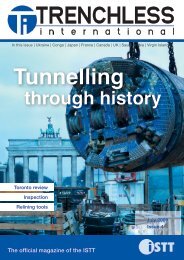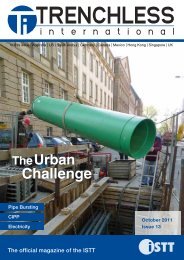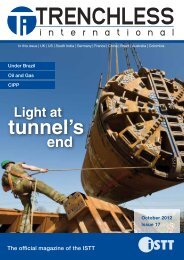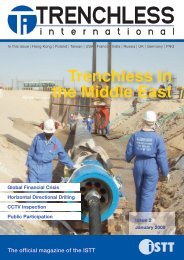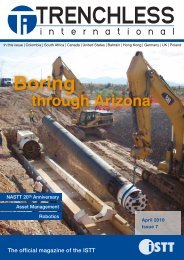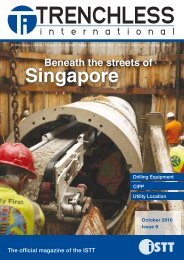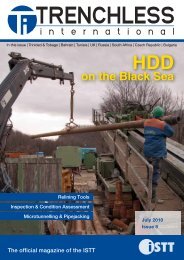North American Special - Trenchless International
North American Special - Trenchless International
North American Special - Trenchless International
You also want an ePaper? Increase the reach of your titles
YUMPU automatically turns print PDFs into web optimized ePapers that Google loves.
Deterioration Factors<br />
Distress Indicators<br />
Preliminary Detailed Preliminary Detailed<br />
Covering your assets<br />
by Hesham Osman and Kevin Bainbridge<br />
Water pH Corrosion potential Leak detection RFEC/TC<br />
Pipe embedment Soil resistivity Visual inspection (test pits) Ultrasonic wall thickness<br />
Backfill type Soil pH, chlorides Pit depth measurement Visual inspection<br />
Cathodic protection<br />
Rate of wire breaks<br />
asset management<br />
April 2009 - <strong>Trenchless</strong> <strong>International</strong><br />
With the Infrastructure deficit in Canada and other countries climbing along with the changing<br />
economy, there is a real need for municipalities and utilities to take a hard look at the way they view<br />
the management of their infrastructure assets. The “asset management” era is upon us and many<br />
municipalities across Canada and internationally are recognising the necessity to change their service<br />
delivery model, essentially re-evaluating how they do business.<br />
The effective management of<br />
municipal water distribution pipes is no<br />
exception and as such, many municipalities<br />
and utilities across the country and<br />
internationally have significantly changed<br />
their philosophical and pragmatic<br />
approach to managing their distribution<br />
systems.<br />
Essential infrastructure<br />
There is a growing need for cities and<br />
water utilities to find better ways to prioritise<br />
their infrastructure asset maintenance,<br />
rehabilitation and replacement projects<br />
and to intefrate infrastructure asset management<br />
techniques into their decision<br />
making. As infrastructure ages, it becomes<br />
increasingly more challenging to assign<br />
limited capital expenditures to the repair,<br />
rehabilitation or replacement of the assets.<br />
The prudent management of water mains<br />
requires a reasonable assessment of its<br />
current condition coupled with a reliable<br />
methodology to forecast future condition<br />
State<br />
Time to second<br />
failure<br />
Time to forth failure<br />
Time to sixth failure<br />
Wiebull Parameter<br />
under different management scenarios.<br />
It can be argued that water mains are<br />
one of the most difficult infrastructure<br />
assets to properly manage in a total asset<br />
management framework. This can be<br />
partly attributed to the difficulties associated<br />
with ascertaining a reliable measure<br />
for their physical condition. Faced with this<br />
challenge, the City of Hamilton embarked<br />
on an ambitious series of studies in 2006<br />
geared towards the creation of a comprehensive<br />
tool set for managing water<br />
mains. The studies encompassed four<br />
main components:<br />
1. Water Main Criticality Model; As the<br />
starting point for risk management,<br />
the criticality model classifies assets<br />
based on their ramifications of failure.<br />
The model encompasses economic,<br />
environmental, social and operational<br />
consequences of pipe failure. The<br />
model defines the subsequent management<br />
practices that will be used<br />
for high, low, and medium criticality<br />
Table 1: Sample Weibull parameters for various material types and failure occurrences.<br />
Pipe Material type/vintage<br />
pipe. For low criticality pipe, failure<br />
can be tolerated and the goal is to<br />
develop sound management policies<br />
that balance life-cycle costs with<br />
acceptable levels of service. For high<br />
criticality pipe, failure is not acceptable<br />
and hence more proactive policies<br />
driven by actual pipe condition and<br />
deterioration factors are sought.<br />
2. Water Main Performance Model; The<br />
challenge associated with developing<br />
a performance model for water mains<br />
stems from the lack of reliable data<br />
on which to base the notion of ‘pipe<br />
condition’. The performance model<br />
is developed for low criticality pipe<br />
and uses the number of breaks as<br />
a proxy for condition. By mining the<br />
break history of various pipe vintages<br />
(ductile iron, cast iron pit cast, and<br />
cast iron spun cast), a life regression<br />
model is calibrated for times between<br />
subsequent breaks. The model is<br />
subsequently used as a forward look-<br />
Ductile CIPIt CISP1 CISP3<br />
Alpha 61.25522 37.27617 37.41538 31.16957<br />
Beta 0.571146 0.720985 0.572962 0.624836<br />
MTTF 98.5903 45.91374 59.94733 44.57487<br />
Alpha 9.02527 11.55926 10.66693 6.648598<br />
Beta 0.450631 0.542016 0.673825 0.704786<br />
MTTF 22.30006 20.13408 14.02286 8.361831<br />
Alpha 8.038522 3.426698 6.747531 4.09902<br />
Beta 0.486966 0.726976 0.49988 0.67752<br />
MTTF 16.90065 4.189806 13.50105 5.358<br />
Soil type<br />
ing predictive model to forecast the<br />
expected failure times. The model was<br />
used to assist in the development of<br />
economic intervention strategies for<br />
replacement and/or rehabilitation, longterm<br />
budget forecasts of repair and<br />
rehabilitation needs in addition to aiding<br />
at the tactical level in rationalising<br />
the coordination of capital works with<br />
sewers and road.<br />
3. Critical Water Main Management; A<br />
unique approach for critical water mains<br />
is developed based on the proactive<br />
collection of condition information. The<br />
framework is composed of two main<br />
components: a condition assessment<br />
rationalisation framework and a condition<br />
rating consolidation framework.<br />
4. Information Management Framework;<br />
The aforementioned components all<br />
require sound and reliable information.<br />
This framework aims to standardise the<br />
way information is used to make decisions<br />
pertaining to water main assets.<br />
The framework is currently developing<br />
standard information policies and practices<br />
that include all stakeholders who<br />
interact with water main information<br />
throughout its life cycle. In addition,<br />
the framework is investigating the most<br />
optimum use of HANSEN (CMMS) to<br />
support existing and evolving business<br />
processes within the City.<br />
Water Main Criticality Model<br />
The premise behind this model stems<br />
from the risk-based prioritisation and decision<br />
making concepts that are entrenched<br />
in the city’s overall approach to asset<br />
management. The intent of this model is<br />
to answer questions such as ‘Which water<br />
mains will have the greatest impact to<br />
the city, should a break occur’ in order<br />
to focus resources and effort on these<br />
assets before they fail. Prior to the establishment<br />
of the criticality model, there was<br />
no standard method for the creation of a<br />
Water Main Criticality Model. It remains a<br />
subjective process in which the municipality<br />
must be heavily involved with the<br />
selection and ranking of parameters that<br />
they feel affect water main rehabilitation<br />
and replacement costs for the local area.<br />
Pressure data<br />
Table 2: Listing of some common distress indicators and deterioration factors.<br />
Because of this, the parameters affecting<br />
cost of rehabilitation and replacement of<br />
water main infrastructure were selected<br />
and ranked within a joint effort between<br />
the consultant and the City of Hamilton.<br />
Examples of criticality parameters<br />
include pipe characteristics such as material<br />
and underground depth, type of land<br />
use in which the pipe is situated, whether<br />
the pipe is connected to major water users<br />
or to important public health facilities such<br />
as hospitals and dialysis centres, whether<br />
the pipe is located in steep slopes or environmentally<br />
sensitive areas.<br />
The application of GIS is particularly<br />
well suited to the development of<br />
Criticality Models because of its ability to<br />
apply many of the criticality parameters<br />
to the segments representing the water<br />
main assets through spatial analysis. Risk<br />
elements were organised into four main<br />
categories:<br />
1. Economic –<br />
influence of the<br />
asset’s failure<br />
on monetary<br />
resources<br />
2. Operational –<br />
influence of the<br />
asset’s failure on<br />
operational ability<br />
3. Social – influence<br />
of the asset’s failure<br />
on society<br />
4. Environmental –<br />
influence of the<br />
asset’s failure on<br />
the environment.<br />
The result of the<br />
criticality model was<br />
the categorisation of<br />
the citys inventory<br />
of water mains into<br />
three distinct groups;<br />
high, medium and<br />
low criticality water<br />
mains. The model<br />
categorised approximately10<br />
per cent<br />
of the network as<br />
having a high criticality,<br />
approximately<br />
20 per cent of the network as medium criticality<br />
and the remainder as low criticality.<br />
Water Main Performance Model<br />
The performance model is geared<br />
towards addressing the needs of low<br />
criticality water mains. The model is based<br />
on a statistical approach founded on<br />
developing mathematical models that utilise<br />
past failure history to forecast future<br />
trends and variations in breakage rates.<br />
As mentioned in the introduction to this<br />
paper, the ST-LR approach models the<br />
time between successive water main failures.<br />
The approach models each failure<br />
number (i.e. 1st failure, 2nd failure, etc…)<br />
as a separate and distinct condition state.<br />
Five distinct cohorts were modelled; three<br />
vintages of Cast Iron (spun cast), pit cast<br />
iron, and Ductile Iron. Other material types<br />
were in use (Hyprotec ductile and plastic)<br />
The Right Tool<br />
Manhole<br />
Renewal<br />
Tool Box<br />
Permacast® Liners<br />
Cor+Gard® Coatings<br />
Permaform ®<br />
Con MIC Shield®<br />
Calcium Aluminate Cements<br />
Water Plug & Patch<br />
COR+ROC Structual Polymer<br />
I & I Barrier®<br />
Top Seal TM CIPP Chimney Liners<br />
Spray Equipment<br />
Applicators<br />
Worldwide in<br />
Denmark,<br />
Ireland, UK,<br />
Singapore,<br />
Israel,<br />
Norway,<br />
Sweden<br />
and USA.<br />
For Every Problem!<br />
AP/M PERMAFORM ®<br />
Fax: +515.276.1274 • www.permaform.net<br />
asset management<br />
April 2009 - <strong>Trenchless</strong> <strong>International</strong><br />
40<br />
41




